| Saturday , December 27 , 2014 |
After that December, everything looked so precious- On December 26, 2004, one of the largest earthquakes ever recorded caused the Indian Ocean to heave gigantic waves at jetliner speeds into coastlines. Some 230,000 people were killed and a dozen countries, from Indonesia to India to Africa’s east coast, were affected. Scores of journalists covered the disaster. Eight journalists — seven from the Associated Press and one from The Telegraph — describe the images that have stuck with them the most |
.jpg) A boy places a rose in the sea in Thailand’s Ban Nam Khem, a southern fishing village that was destroyed by the tsunami, on Friday. (Reuters) It seemed extraordinarily emblematic of the suffering that had engulfed the coastline not just of Thailand, but many other countries, too. Jerry Harmer AP video editor The image that stuck with me most was the mass grave in Aceh, Indonesia. Bodies littered the street, stuck on tall trees. Some were eaten by dogs. No matter how hard the officials worked, there were just too many bodies. There was only one helpless excavator, which couldn’t keep up with the flow. This left the bodies piled up untouched for days, maybe even weeks. Seeing hundreds of dead bodies every day just made me appreciate life more, the air that I breathe and also the sun that I always complain about because it’s too hot here where I live. That assignment brought me back to the reality that I have everything I need.…After that assignment, everything looked so precious. Dita Alangkara Photographer for AP As my car drove down towards Khao Lak, Thailand, I stared out of the window. This normally dreamy beach of white sand and saggy coconut trees was lined with coloured debris as far as my eyes could see. Such a colourful mess, I thought. Our driver slowed the car, seeming to realise as I was, that this colour was not garbage or wreckage, but bodies. The bodies of tourists, wrapped in the festive colours anyone might wear to a beach holiday. Bright yellows and deep reds, swimsuits and sundresses. The silence was deafening. No other living soul was near us. That image, and the shocking moment I realised the scale of the catastrophe, has never left me. Tassanee Vejpongsa Video journalist I came across a small group of survivors (in the then Tamil Tiger-held area in northern Sri Lanka). There was no food. Everyone was starving. We came with nothing to offer. Later that day, volunteers delivered some bread to the suffering group by truck. I saw a boy holding his father’s hand as he tearfully bit into a piece of bread, his first food in who knows how long. I have often thought of this boy and the other children I met there, and how strong they had to be to survive. Wally Santana Photographer I accompanied a body collecting team as it plumbed wrecked villages in Banda Aceh, Indonesia. Once their rickety van was filled with bodies, it would dart across the city to a mass grave, siren wailing. I rode beside the driver…. What moved me were the sights of people along the street as the van drove by with a smell so strong there could be no doubt about what it contained. Most people turned their backs and walked briskly away. Some did not, including a despondent, unkempt man who looked like a father, and a downcast woman with a child. They covered their noses like everyone else, but examined our passing van as if whoever they were looking for might be inside. Their eyes stayed fixed on the van until it vanished from sight. Jim Gomez Chief correspondent, AP, the Philippines The Khao Lak beach in Thailand looked like it had been carpet-bombed. As I walked around taking pictures, I would find body parts, pieces of clothes and luggage in trees — and silence. The silence is something I’ll never forget. Richard Vogel Photographer At the fishing harbour in Tamil Nadu’s Nagapattinam, a three-storeyed building had a trawler on its roof. Clothes donated from across the country had made a hillock in front of the district collector’s office. On closer examination, they turned out to be blankets, mostly. Blankets for people in sub-tropical Tamil Nadu! But the intention was well-meaning. These two images have stayed with me. Sujan Dutta The Telegraph Standing among the tsunami’s victims at Galle in Sri Lanka, I received some news that made me want to celebrate. This was the awful dissonance of the Indian Ocean catastrophe, which strained the imaginations of many of those who witnessed its power, in the moment and in the aftermath. This time, it was difficult to focus on the job. My brother had been vacationing in the Maldives, a low-lying archipelago that was hit by the tsunami. My family had lost contact with him. In those early hours, worried about my brother, I drove to the devastated Galle. At the hospital entrance, a tractor arrived with bodies piled on a cart. Hundreds lay in rows, swelled up but mostly without visible injury. Sometimes, I studied them. Sometimes, I averted my eyes. From one angle, they didn’t seem so distant from life; from another, they were alien and remote. I felt shame, fascination, pity and disconnection. An awful dissonance. Then came a text message. My brother was safe. I paused among the dead, quietly elated. Nearby, townspeople searched for missing relatives, scanning the rows of faces on the ground. Christopher Torchia Bureau chief, AP, southern Africa http://www.telegraphindia.com/1141227/jsp/frontpage/story_5434.jsp#.VJ3t6sAKA Then and Now: Tales of tsunami devastation and rebuilding in 15 picsHindustan Times Cuddalore/Nagapattinam, December 23, 2014In the morning of December 26, 2004 a 9.3-magnitude earthquake off Indonesia's western coast generated a series of massive waves that killed more than 220,000 people across 14 countries as far apart as Indonesia, India, Sri Lanka and Somalia. As many as 16,000 people died, communities were destroyed and there was massive material damage in India. Photos shot days after tsunami struck the country captured the scale of the damage. Ten years later, Hindustan Times' national photo editor Gurinder Osan revisits the places he had clicked on his 2004 tsunami assignment in Tamil Nadu. Hold the tab button at the centre of the photographs and swipe to see places then and now. Tsunami destroyed this car and flooded fields next to a road that leads to Silver Beach in Cuddalore, Tamil Nadu. Ten years later, the same spot has sprung back to life. (HT Photo/Gurinder Osan) Tsunami survivors scurry to get on a ferry across the Kaduvaiyar river and reach the fishermen's village of Akkaraipettai in Nagapattinam (left). Ten years on, the same place has a booming fishing trade. A flyover started 10 years is now complete. (HT Photo/Gurinder Osan) People carry dead bodies amid debris near the harbour in Nagappattinam after the tsunami in December 2004. When HT visited the place last week, we found buildings and a smiling balloon-seller. (HT Photo/Gurinder Osan) The tsunami shattered the fishermen's village of Akkaraipettai in Nagapattinam, Tamil Nadu, and damaged roads. There is now a paved road at the same place which children use to get to their school. (HT Photo/Gurinder Osan) A woman walks through the ruins of the fishermen's village of Akkaraipettai after the tsunami waves damaged the area (left). Today, the same place is a small market where people sell fish and vegetables. (HT Photo/Gurinder Osan) Fishing boats were washed in by the tsunami waves and pushed on a bridge in the fishermen's village of Akkaraipettai in Nagapattinam, Tamil Nadu. The boats are back now but the bridge was never rebuilt. (HT Photo/Gurinder Osan) Women grieve as they cross fishing boats washed ashore by tsunami waves. That bridge has now been demolished. (Photo on left: AP archive; on right: HT Photo/Gurinder Osan) Fishing boats were washed ashore by tsunami waves near the fishermen's village of Akkaraipettai in Nagapattinam, Tamil Nadu (left). There is now a bridge at the same place. (HT Photo/Gurinder Osan) Tsunami victims were buried en masse in Cuddalore, Tamil Nadu. Ten years later, the dead have got better treatment. There is a memorial where people homage. (Photo on left: AP archives; on right: HT Photo/Gurinder Osan) A person seems shell-shocked by devastation caused by the tsunami waves in the village of Devanampattinam in Cuddalore. The same place isn't grim now: it has a volleyball net where youngsters gather to play. (HT Photo/Gurinder Osan) An old couple cries over the wreck the tsunami waves created after crashing Nagappattinam, Tamil Nadu (left). Ten years later, three young men smile and pose for the camera at the same spot. (Photo on the left: AP archives; on the right: HT Photo/Gurinder Osan) People look grim as they cross a tsunami-damaged road that leads to the Silver Beach in Cuddalore, Tamil Nadu (left). The road is well paved now and the photo frame has changed to children happily running along. (Photo on the left: AP archives; on the right: HT Photo/Gurinder Osan) Silver Beach in Cuddalore took a pounding during the December 2004 tsunami. Ten years later, grim faces have replaced happy faces licking ice-creams. The beach is a picnic spot again. (HT Photo/Gurinder Osan) Men try to pull a damaged autorickshaw from the rubble left behind by the tsunami waves. It's not the same auto but the fishermen's village of Akkaraipettai in Nagapattinam is back to normal. (Photo on the left: AP archives; on the right: HT Photo/Gurinder Osan) People walk away from their damaged homes after the tsunami hit Akkaraipettai in Nagapattinam, Tamil Nadu. Today, the village is back to life. (HT Photo/Gurinder Osan) http://www.hindustantimes.com/india-news/in-pics-15-places-unmade-and-made-by-tsunami/article1-1299630.aspx |
Indian Ocean Tsunami – then and now
![]() THE INDIAN OCEAN TSUNAMI, 10 YEARS LATER
THE INDIAN OCEAN TSUNAMI, 10 YEARS LATER
It has been a decade since a tsunami hit most of South-East Asia, causing significant death and destruction. Click through to see images as we revisit the affected areas.
On December 26, 2004, an earthquake off the west coast of Sumatra, Indonesia triggering a tsunami that affected countries in the Indian Ocean. The worst hit were Indonesia, Sri Lanka, Thailand and India. In this composite image photographed at Banda Aceh, Indonesia, a comparison has been made between a scene in 2004 (TOP) and 2014 (BOTTOM).
 The Indian Ocean tsunami is considered to be one of the worst natural disasters in recent history, killing almost 250,000 people across 14 countries. In this composite image photographed at Aceh, Indonesia, a comparison has been made between a scene in 2004 (TOP) and 2014 (BOTTOM).
The Indian Ocean tsunami is considered to be one of the worst natural disasters in recent history, killing almost 250,000 people across 14 countries. In this composite image photographed at Aceh, Indonesia, a comparison has been made between a scene in 2004 (TOP) and 2014 (BOTTOM).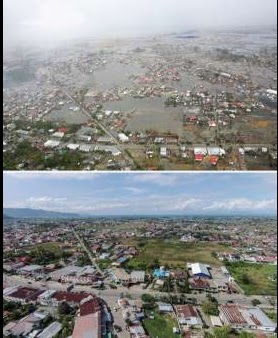 The 9.1 magnitude of earthquake caused waves almost 30 meters high. In this composite image photographed at Banda Aceh, Indonesia, a comparison has been made between a scene in 2004 (TOP) and 2014 (BOTTOM).
The 9.1 magnitude of earthquake caused waves almost 30 meters high. In this composite image photographed at Banda Aceh, Indonesia, a comparison has been made between a scene in 2004 (TOP) and 2014 (BOTTOM). 
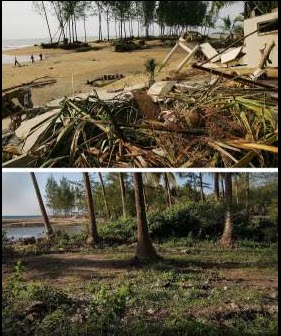 In this composite image photographed at Khao Lak, Thailand, a comparison has been made between a scene in 2004 (TOP) and 2014 (BOTTOM). A popular tourist destination, many tourists died in 2004 when their upmarket bungalows were swept away by the tsunami at the Theptharo Resort. The resort was never rebuilt, and rubble was still strewn throughout the new forest growth on December 11, 2014.
In this composite image photographed at Khao Lak, Thailand, a comparison has been made between a scene in 2004 (TOP) and 2014 (BOTTOM). A popular tourist destination, many tourists died in 2004 when their upmarket bungalows were swept away by the tsunami at the Theptharo Resort. The resort was never rebuilt, and rubble was still strewn throughout the new forest growth on December 11, 2014.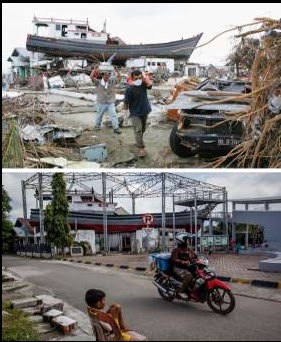 The top photograph shows devastation in Banda Aceh, Indonesia, taken on January 4, 2005. The bottom picture of same place was taken on December 10, 2014.
The top photograph shows devastation in Banda Aceh, Indonesia, taken on January 4, 2005. The bottom picture of same place was taken on December 10, 2014.The picture above (top) shows Banda Aceh, Indonesia on December 28, 2004. The same place was photographed (bottom) on December 11, 2014.
 This combination picture (top) shows tourists walking past destruction on Patong beach in Phuket, Thailand, on December 27, 2004. The bottom picture shows the same location on December 10, 2014.
This combination picture (top) shows tourists walking past destruction on Patong beach in Phuket, Thailand, on December 27, 2004. The bottom picture shows the same location on December 10, 2014.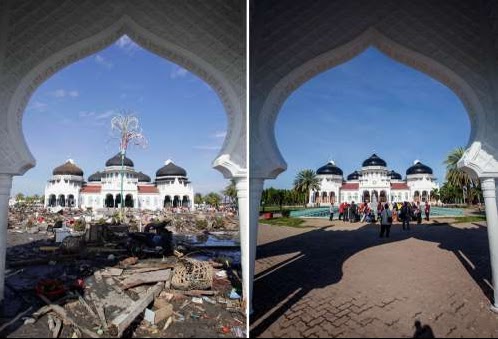 The left picture shows Banda Aceh in Indonesia on December 28, 2004, and same place was pictured (right) on December 11, 2014.
The left picture shows Banda Aceh in Indonesia on December 28, 2004, and same place was pictured (right) on December 11, 2014. The left picture shows Indonesia’s Banda Aceh on January 8, 2005. The same location is pictured (right) on December 11, 2014.
The left picture shows Indonesia’s Banda Aceh on January 8, 2005. The same location is pictured (right) on December 11, 2014. The picture above (top) depicts a destroyed hotel in Phi Phi Island, Thailand, on December 28, 2004. The image on the bottom shows the same place on December 12, 2014.
The picture above (top) depicts a destroyed hotel in Phi Phi Island, Thailand, on December 28, 2004. The image on the bottom shows the same place on December 12, 2014.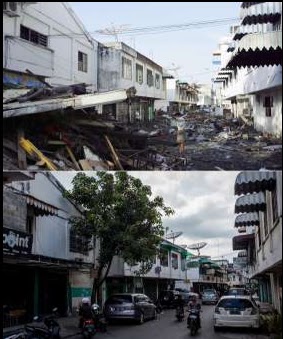 This combination picture (top) shows the Indonesian City of Banda Aceh on December 28, 2004. The bottom picture shows the same location on December 10, 2014.
This combination picture (top) shows the Indonesian City of Banda Aceh on December 28, 2004. The bottom picture shows the same location on December 10, 2014.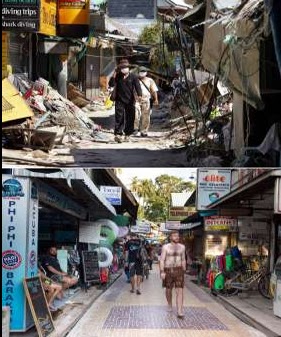 The top picture was taken on January 25, 2005, showing Phi Phi Village, Thailand. The bottom picture of same location was taken on December 11, 2014.
The top picture was taken on January 25, 2005, showing Phi Phi Village, Thailand. The bottom picture of same location was taken on December 11, 2014. The top picture shows Banda Aceh in Indonesia on December 28, 2004. The same place is pictured (bottom) on December 10, 2014.
The top picture shows Banda Aceh in Indonesia on December 28, 2004. The same place is pictured (bottom) on December 10, 2014. A composite image shows Phi Phi village, Toni Sai Bay, Thailand on December 28, 2004 (left) and on December 12, 2014 (right).
A composite image shows Phi Phi village, Toni Sai Bay, Thailand on December 28, 2004 (left) and on December 12, 2014 (right).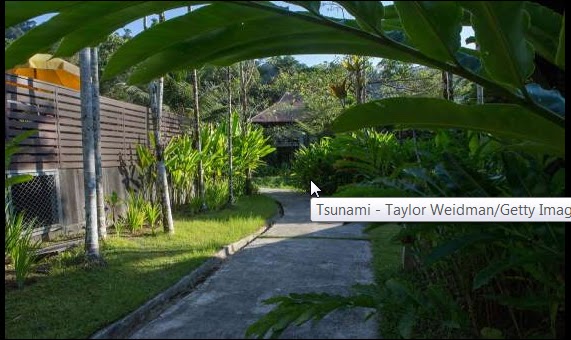 The Wannaburee Resort in Khao Lak, Thailand, was destroyed by the tsunami a decade ago. Here, it's pictured on December 11, 2014.
The Wannaburee Resort in Khao Lak, Thailand, was destroyed by the tsunami a decade ago. Here, it's pictured on December 11, 2014.  Workers installing the names of victims of the 2004 Indian Ocean tsunami on the wall of the Tsunami Museum in Banda Aceh, Indonesia.
Workers installing the names of victims of the 2004 Indian Ocean tsunami on the wall of the Tsunami Museum in Banda Aceh, Indonesia.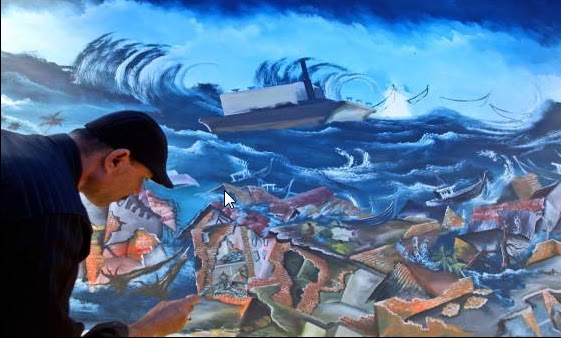 A local artist finishing his painting titled ‘Lautan Jenazah’ (Ocean of Bodies) ahead of the 10th anniversary of the killer waves in Lambada, Indonesia.
A local artist finishing his painting titled ‘Lautan Jenazah’ (Ocean of Bodies) ahead of the 10th anniversary of the killer waves in Lambada, Indonesia.  A memorial commemorating the 2004 tsunami in Banda Aceh, Indonesia. The copper-colored sculpture symbolizes the height and color of the massive waves, while the time on the clock is stopped before 8 a.m., the moment when the earthquake struck, unleashing the tsunami.
A memorial commemorating the 2004 tsunami in Banda Aceh, Indonesia. The copper-colored sculpture symbolizes the height and color of the massive waves, while the time on the clock is stopped before 8 a.m., the moment when the earthquake struck, unleashing the tsunami.






















